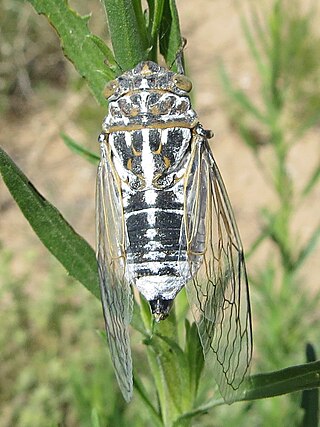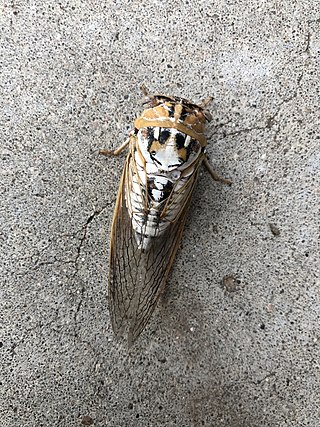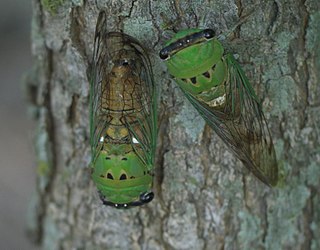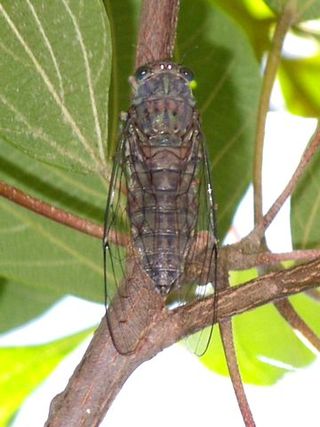
Cicadas of the genus Neotibicen are large-bodied insects of the family Cicadidae that appear in summer or early fall in eastern North America and formerly Bermuda. Common names include cicada, harvestfly, jar fly, and the misnomer locust.
Tibiceninae is a former subfamily name from the insect family Cicadidae. It was first used by Distant (1889). As of 2021, the name became unavailable to zoological nomenclature due to the suppression of its type genus Tibicen Berthold, 1827 by the International Commission on Zoological Nomenclature. Cicada genera grouped at the subfamily level with genus Lyristes are generally referenced under the name Cicadinae Latreille, 1802.

Cryptotympanini is a tribe of cicadas in the family Cicadidae. They are found in the Nearctic, Palearctic, Indomalaya, Oceania, and Afrotropics.
Tibicenini is a former tribe name from the insect family Cicadidae, based on the family group taxon established by Distant (1889). As of 2021, the name became unavailable to zoological nomenclature due to the suppression of its type genus Tibicen Berthold, 1827 by the International Commission on Zoological Nomenclature. Cicada genera grouped at the tribe level with genus Lyristes are generally referenced under the name Cryptotympanini Handlirsch, 1925.

Neotibicen tibicen, known generally as the swamp cicada or morning cicada, is a species of cicada in the family Cicadidae. It is widespread across much of the eastern and central United States and portions of southeastern Canada. There are two subspecies, N. tibicen tibicen and N. tibicen australis, with the latter replacing subspecies tibicen in portions of Florida, Georgia, and Alabama.

Tibicen is a former genus name in the insect family Cicadidae that was originally published by P. A. Latreille in 1825 and formally made available in a translation by A. A. Berthold in 1827. The name was placed on the Official Index of Rejected and Invalid Generic Names in Zoology by the International Commission on Zoological Nomenclature in 2021. Certain European cicada species that were included by some authors in this genus at the time of its suppression are now listed under genus Lyristes Horváth, 1926. Other formerly-Tibicen species are placed in the tribe Cryptotympanini and include the genera Auritibicen Lee, 2015, Hadoa Moulds, 2015 Megatibicen Sanborn and Heath, 2016, and Neotibicen Hill and Moulds, 2015.

The genus Hadoa comprises large-bodied Cicadidae occurring in Western North America. Until recently, these species were in the genus Tibicen, which has now been redefined so as to include only a few European species, while most species from the Eastern and Central US are now placed in Neotibicen and Megatibicen.

Megatibicen dealbatus, commonly called the plains cicada, is a species of annual cicada. Dealbatus is Latin for "whitewashed".

Megatibicen is a genus of cicadas in the family Cicadidae, with about 10 described species. Until 2016, these species were included in the genus Tibicen and then briefly in Neotibicen. The species formerly of genera Ameritibicen Lee, 2016 and Gigatibicen Lee, 2016 are now considered species of Megatibicen Sanborn & Heath, 2016.

Neotibicen superbus, the superb dog-day cicada, is a species of cicada in the family Cicadidae. It is the greenest cicada in the neotibicen genus. It has reduced black patterning and looks different than most other cicadas in its genus. Its song is a soft buzz that reaches a crescendo.
Diceroprocta aurantiaca is a species of cicada in the family Cicadidae. It is found in North America.
Cornuplura nigroalbata is a species of cicada in the family Cicadidae. It is found in Central America and North America.
Cornuplura is a genus of cicadas in the family Cicadidae. There are at least three described species in Cornuplura.
Cacama maura is a species of cicada in the family Cicadidae. It is found in Central America.
Cacama collinaplaga is a species of cicada in the family Cicadidae. It is found in North America.
Cacama dissimilis is a species of cicada in the family Cicadidae. It is found in Central America and North America.

Leptopsaltriini is a tribe of cicadas in the family Cicadidae. There are at least 200 described species in Leptopsaltriini, found in the Palearctic, Nearctic, and Indomalaya.

Macrotristriini is a tribe of cicadas in the family Cicadidae. There are at least 2 genera and 20 described species in Macrotristriini, all found in Australia.

Oncotympanini is a tribe of cicadas in the family Cicadidae, found in China and southeast Asia. There are at least 3 genera and about 12 described species in Oncotympanini.

Megatibicen resh, the resh cicada or western dusk singing cicada, is a species of cicada in the family Cicadidae, found in North America.












